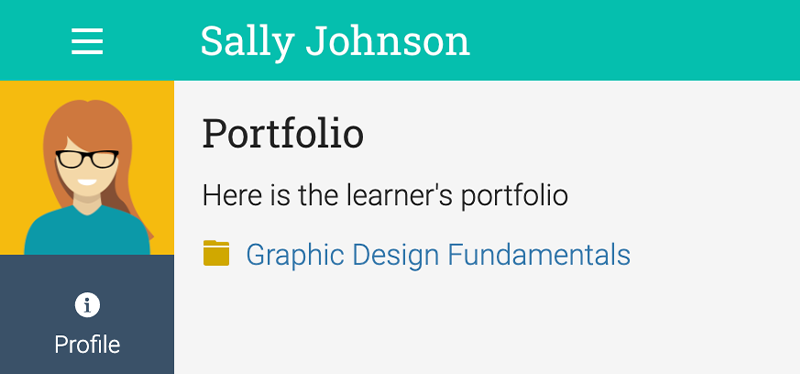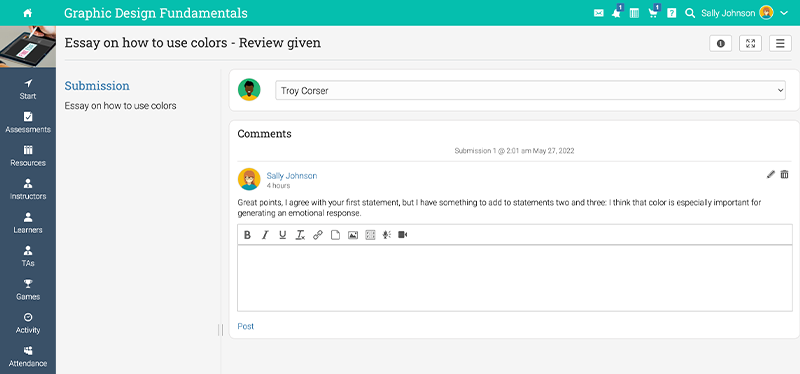Giving feedback is not easy. It takes patience and experience to do so effectively without feeling uncomfortable or making the other person feel overwhelmed.
Consequently, many professionals are struggling to learn how to give feedback to peers effectively without judging or being judged. Constructive feedback is vital for a team and for the company's overall well-being. Giving and receiving feedback, be it positive or negative, is the only way to grow. This is very important in a remote work environment that promotes individual development but often fails to foster communication within the company.As a trainer or manager, you probably want to create a collaborative company culture that centers on open communication, especially in a remote environment. Learn how to teach remote employees to give constructive feedback to their peers.
Why is it important to provide constant and constructive feedback?
If you’re an L&D specialist, you probably hear the word “feedback” a trillion times a year. Feedback is important because it helps you see how employees perceive your training courses and the value it brings them. Feedback is also needed to understand what more they expect from you and the company as a whole. In the absence of feedback, you wouldn’t know how to steer the ship in the right direction to make sure your training efforts have good results.
Feedback has to be constructive, honest, and constant. You can’t know if the feedback you received for today’s training session still applies tomorrow. And if this feedback is negative? Hard as it seems, you shouldn’t take it personally but use it as an opportunity to improve yourself professionally — not only.
Feedback among remote employees is important for the same reasons. It helps:
- Enhance employee performance;
- Set clear goals and expectations;
- Boost employee confidence;
- Improve peer communication and collaboration;
- Strengthen leadership;
- Foster an open company culture;
- Improve employee loyalty.
Read more: 360-degrees feedback: A more accurate strategy for coaching programs
8 Tips for teaching remote employees how to give feedback to peers
How to give feedback to peers and teach employees to do the same? There are different tried and tested strategies to rely on. While these tips can be taught as part of a training program, leading by example is the best way to ensure employees adopt the most productive behaviors. Anyone in the organization can understand and leverage them if they’re willing to listen, patient to learn, and eager to improve their communication and team management skills. They are:
-
Focus on improvement, not on blame
Feedback is all about letting employees know how they’re doing at work. Everyone needs this — even if the feedback is negatively perceived either because it is not communicated effectively or simply because of faulty performance or result.
However, even negative feedback can be shared in a positive way by focusing on the improvement possibilities it unlocks rather than on trying to find someone to blame. The latter only makes people feel ashamed, guilty, or scared.
Usually, when people get negative feedback, they tend to be defensive. Try to mitigate defensive behavior at work by always focusing on at least one positive aspect while providing feedback. A good and well-known strategy is to start with the positive part before moving on to the negative aspects.
-
Set examples for success
One of the main reasons why employees can’t positively incorporate peers' feedback into their work is that they don’t have clear examples of what they have to do. This is something I frequently encountered in my career when clients told me they wanted something different but couldn't provide a clear example of what different looked like, so I could improve my work.
The same applies to any line of work. An employee might immediately understand that the project their colleague worked on didn't turn out quite well. Yet, if they simply rate their work “below expectations” or label it as wrong, they don’t actually help their colleagues fix their mistakes or motivate them to improve.
Instead, by offering concrete examples of how to improve, an employee can easily understand what went wrong. Comparison will allow them to make the necessary adjustments and remember how to proceed in similar situations in the future. Most importantly, concentrating on the example and not on someone’s “faults” usually makes people less defensive and more likely to be solution-oriented.
-
Provide actionable feedback
When peers provide feedback to one another, they should do it from a practical, straightforward, and goal-oriented perspective. The person receiving the feedback doesn’t just need appraisal or critical words. They need facts, numbers, concrete details, and indications that can help them boost their performance.
Here are two examples of actionable and non-actionable feedback:
- Non-actionable feedback:
“I love what you’ve done with the re-branding strategy, I’m sure it will look awesome. But maybe you can go through it again; I feel that there are still parts we could improve. Maybe you can focus more on showing the human side of our client’s business.”
- Actionable feedback:
“Your re-branding ideas were great, you’ve done an excellent job! I have a few improvement ideas, though. They’ll help us highlight the human side of the client’s business and get them closer to their potential customers. Here are my ideas and maybe you’d like to add yours as well: ..."
-
Don’t make it a monologue
Trainers and L&D specialists often talk about the importance of a two-way conversation in corporate development programs. Simply talking without listening or passively listening without intervening in a conversation minimizes the engagement, impact, and efficiency of any discussion.
Two-way conversations are meaningful, intellectually and emotionally stimulating, and efficient. Among the advantages of having a two-way conversation when delivering feedback to peers, we can count the following:
- Help employees establish a genuine connection and exchange ideas;
- Allow both or all employees to gain valuable, candid insights;
- Improve their communication and collaboration skills;
- Boost peers’ trust in one another and self-confidence;
- Be more efficient and goal-oriented;
- Two-way communication allows participants to give and receive instant feedback.
A two-way conversation teaches people both how to talk and listen. It builds human connection and establishes trust. Ditching the monologue for two-way conversations helps engage in talks with an open mind and more willingness to be empathetic.
Read more: What to do about your organizational culture after the crisis
-
Try to mitigate defensiveness
Employees can become defensive when they receive negative feedback. This is usually an impulsive, often uncontrollable reaction.
All sorts of emotions can overwhelm an adult when they get negative feedback from peers or their manager: shame, anger, self-resentment, and even fear. None of them are usually positive because few people have the right mindset to accept negative feedback and turn it into a positive outcome. It’s also hard to keep a positive mindset if that feedback is communicated in a disrespectful way, at the wrong moment, or simply centers on blame, not on improvement opportunities.
Mitigating negative emotions in defensive people is hard when you communicate less than perfect feedback. Employees need to know how to give feedback to peers without altering its essence and helping them feel comfortable while receiving it. Here are a few practical tips to mitigate defensive behavior:
- Be respectful at all times, use appropriate language;
- Use more mild synonyms (e.g., “not perfect” instead of “bad”; “you were not quite right” instead of “you were wrong”);
- Use the passive voice more often to diminish culpability (e.g.”‘the deadline was missed because the client didn't receive all the information” instead of “you forgot to send all the necessary information and now we missed the deadline because of you’);
- Keep the conversation professional, not personal. Many people tend to take it personally when they receive negative feedback. Instead of asking themselves, “how did my actions impact my department?” thoughts such as “this colleague hates me” echo for a long time. Moreover, not being liked by someone is the easiest way to justify negative feedback. To avoid this unproductive behavior, it’s essential to focus on the professional side of things.
By insisting on the consequences each person’s performance has on the organization, it’s easier to make them take ownership and understand that the negative feedback they are getting is unbiased and needed to avoid future mistakes.
-
Pick the right moment
feedback is not always easy, especially if what you’re about to say is a mix of good and bad news or more of the latter. However, the earlier you spot and talk about a problem, the better for everyone. Early feedback is critical, especially for new hires who need more support as they’re getting started. It sets employees on the right track, establishes clear expectations and goals, promotes an open company culture and strengthens employee satisfaction, among others.
Nonetheless, early feedback doesn’t necessarily mean you can’t give people enough time to adapt to a new job position or project. The ideal time to have a feedback discussion is after the person has had the opportunity to get acquainted with their position and the chance to prove what they can do. If you stop and criticize them right from day one, it might affect their confidence and future results.
Even if an employee has been working for a long time in the company, it’s still necessary to teach remote peers to pick the right moment to give them feedback such as:
- At the beginning of the day, before they start focusing on other tasks, so you don’t disrupt them from their work;
- At the end of the day, when they’re almost done working and are no longer in a hurry to complete time-bound tasks;
- Right after the lunch break, when they take time to disconnect, so they can focus on your feedback and capture its key takeaways;
- Whenever they are less busy, able to take a break and engage in a genuine and valuable conversation.
On the contrary, some of the worst moments to deliver feedback might be:
- Right before an important meeting;
- When the person is very busy;
- After they’ve had a long, maybe uncomfortable conversation with their manager;
- When they are in a rush to finish work as they have personal matters to attend to;
- After a general meeting in which the manager gave all of you bad news.
Picking the right moment to give effective peer-to-peer feedback shouldn’t be difficult if employees can put themselves in their peers’ shoes to engage in a productive work conversation. Sets employees on the right track;
-
Use the LMS collaboration features for feedback
Employees can also use learning platforms to deliver and receive feedback. Here is how you can teach employees to use your company’s learning management system (LMS) to ask, send, receive, and discuss feedback.
The easiest way to substitute in-person conversations is by relying on digital tools. Talking on the phone helps. However, it might not be the most appropriate way to deliver peer feedback because a lot of what is being said can be misunderstood, forgotten, or misinterpreted due to a lack of visual support and non-verbal cues.
Instead, by delivering feedback, at least partially, in writing, the person receiving it has time to reflect on its content, come back to it for future reference, add comments, and ask questions easier as the entire information is and remains registered. LMS features that support this include groups, forums and messages.
Additional LMS features such as integrations with video conferencing tools also allow them to jump on a call to make the conversation more personal and engaging.
Read more: Why intelligent learning platforms help hybrid employees be more productive
-
Use LMS assessment features to get and offer peer feedback
LMSs also offer a wide variety of tools that facilitate assessment and offer a more accurate strategy for coaching and mentorship programs. Employees can also use them to provide feedback. Here are some examples.
- Portfolios
Once an employee uploads or creates a new project on the LMS, their peers can easily access their digital portfolio and offer feedback to help them improve their work.

- Peer-reviewed assessments
If you’re wondering how to give good feedback to peers for their learning efforts, an LMS can ease your work. Some systems offer more than a dozen assessment tyes that can help evaluate employee performance and knowledge. Employees can also ask peers to check these assessments to get feedback from someone who has more hands-on experience.

- Team assessments
Team assessments are a great way to boost team cohesion and collaboration. As a trainer, you can divide employees into several workgroups, assign them a project where each group has to carry out specific tasks, and then evaluate their work as a whole. Team assessments offer employees the opportunity to collaborate, discover each others’ work styles and thought processes, and apply these insights on the job.

How to give feedback to peers?
There are many ways to deliver constructive feedback at work. As an instructor, it is part of your job to give and receive feedback constantly, but it is also essential to teach employees how to give feedback to peers. The tips above will help you help them deliver feedback in a positive, goal-oriented way. Plus, learning platforms are also here to ease your job by enabling employees to communicate, exchange feedback, and review each other’s work.







